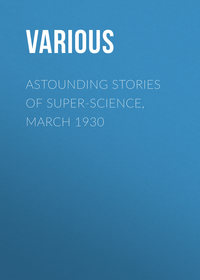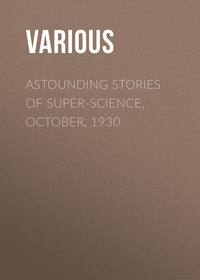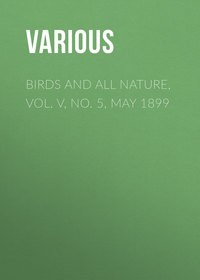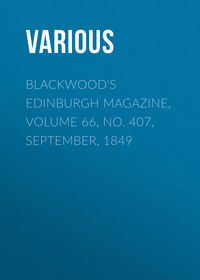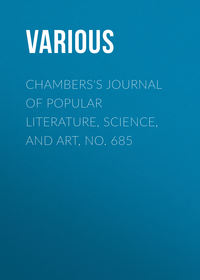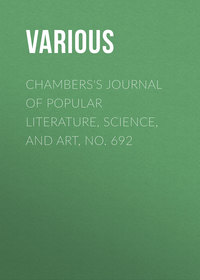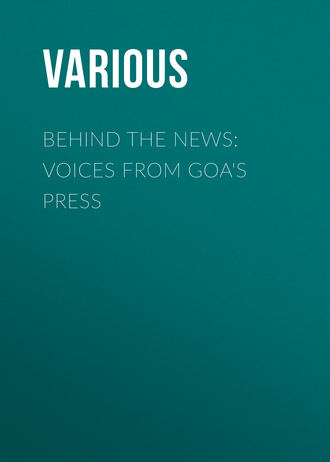 полная версия
полная версияПолная версия
Behind the News: Voices from Goa's Press
In the course of time, the Portuguese language could not meet the bare economic needs of the people and gradually they had to learn English in order to get access to jobs outside Goa. Thus the Catholic community was completely cut off from the Devnagri roots.
With the advent of Liberation and after the official status was granted to Konknni with Devnagri as its official script, the younger generation is now coming in increasing touch with the Devanagiri script. If the trend continues successfully, we hope that after 25 to 40 years or so, we will have a new generation to whom reading Konknni in the Devanagiri script will be easy. Till then, the present generation will need the services of Roman script Konknni for at least another 30 to 40 years. This is a foregone conclusion.
However this is not to water down the bright chances Romi Konknni journalism has in the future. If, in the course of coming 25 years it makes large strides in terms of excellent literary, scientific and religious publications and keeps abreast with modern journalistic trends, then Romi Konknni will not easily die but will survive for a long time to come.
Present-day Romi Konknni media
The weekly Vavraddeanchi Ixtt and the monthly, Gulab are the only complete Romi Konknni publications of Goa today. Recently, in early October 2003, Ixtt celebrated its 70th annual day and Gulab has completed 20 years of existence. Today Vauraddeancho Ixtt (Worker's Friend) is the only weekly that has survived (since 1933) and is thriving to meet the present day challenges of the fast moving media. Started in 1933 in the backdrop of the spread of Communism, the weekly was to reach out the working class and people at the grassroots to educate, inform and educate them on Communism vis-a-vis religion. However, over the years, and as it gained wider popularity, the scope extended to the coverage of social, political, cultural and religious themes. Ixtt can boast of a glorious past as one weekly that provided news and views that satisfied the reading appetite of a large readership in Goa and Mumbai. Having run by priests and the Society of Pilar, its credibility and respect always remained consistent.
Ixtt's contribution to the freedom movement of Goa is worth the mention. Ixtt under the aegis of the Society of Pilar followed a line of thought closer to the aspiration of the freedom movement of our Motherland India and Goa. It was on the Vespers of the independence of India that Ixtt began to publish from the precincts of the old Monastery of Pilar, where its editorial office and press was housed.
The weekly enjoyed quite good freedom to express itself without rigorous Portuguese censorship upto the early 50's. However, the picture started changing after the Liberation of Dadra and Nagar Haveli and the freedom struggle movement to liberate Goa from the clutches of the Portuguese. During this period, the Press buckled under the pressures of rigorous Portuguese censorship. Nothing could be published in Goa without getting it censored by the Portuguese Police with the rubber-stamp of approval that read 'Visado pela censura' (Seen by the Censor).
Ixtt, under the editorship first of Fr. Conceicao Rodrigues (1944-54) and later of Fr. Jeronimo Pereira (1954-69), had to face insurmountable pressures to toe the Portuguese line. In order to survive most of the times, Ixtt maintained silence towards the policies of Salazar the Portuguese dictator without however openly criticizing the Portuguese Government, which would be suicidal. But this silence was construed as opposition to the Portuguese Sovereignty in Goa.
On August 12, 1961, three months before the liberation of Goa, the Governor Vassalo da Silva, by his decree, suspended the publication of Ixtt for 90 days as a punishment for not being patriotic towards Portugal and showing pro-India tendencies. Thus Ixtt was the only paper of Goa which remained firm and suffered for its nationalistic aspirations.
Today Ixtt still continues to be popular. Since more than a year, Ixtt has seen lot of changes in content and presentation. In keeping with modern trends in journalism and the needs of readers, Ixtt is slowly but steadily progressing. At present Ixtt has almost 7000 regular subscribers and in fact this number is increasing at an unexpected rate. After a systematic campaign started recently, Ixtt hopes to cross the 10,000 figure before 2004. While Ixtt was online since 1999 sharing a link on Goacom.com, today it has its own website (http://www.v-ixtt.com).
Gulab is another magazine, which is on the lips of every Romi Konknni reader in Goa and even abroad. Started in 1983 by Fr. Freddy D'Costa, who continues to be its editor, Gulab has maintained a certain standard in its language and has strived to keep up the tempo of advancing journalism.
This monthly is printed in a magazine format, with an attractive glossy and coloured cover. Writings of interests to the young, old, children and women and on literature are included, besides covering news on films, Konknni language and culture. Sports and tiatr have projected this monthly as a popular family magazine. Gulab is also online with its own website (http://www.gulabonline.com). By running this magazine single handedly since the last 20 years, Fr. Freddy D'Costa will surely go down in the annals of Roman Konknni journalism. If the Gulab (literally meaning 'rose') is still blooming it is because of the support of its founder and his Press – New Age Printers.
Scope & Challenges?
A large section of the Konknni-speaking people still reads Roman Konknni. This section reads neither English nor the Devnagri and is totally dependent on Roman Konani literature. Besides there are a lot of people who read English as well as Roman Konknni, who want to read in the vernacular and get a different slant in coverage. Therefore, to say that the demand for Roman Konknni will go for another 25 to 40 years will not be inaccurate. This is strongly complimented by the Church factor. Meaning, till the Church transliterates its entire set of Roman-script liturgical, ritual and other holy books to Devanagiri, the use of Roman Script will not die.
There is also an increasingly felt demand among the Diaspora population of Romi Konknni-speaking people who are migrating to other countries over the globe. This population will also take more than a generation to assimilate the language or culture of the residing countries. Further, if care is taken to make these papers or periodicals at the same time competitive, attractive, people-friendly and useful, then the scope and longevity of Roman Konknni journalism will be ensured.
Roman Konknni journalism needs to be more aggressive in their marketing strategies. Over the years, it has relied more on well wishers and only subscribers. Many times huge loses have incurred and had to be borne by publishers. It cannot afford to rely on donors, individual persons or trusts for its existence. Without shedding its principles, it needs to look to adapting to new trends, being more competitive, and delivering the needs of the readers. These are some of the serious challenges that needs immediate attention. At this given period of time, there are a few Roman Konknni writers. However that there is huge potential is a fact that needs to be exploited and utilized.
Conclusion
With just two periodicals around, Roman Konknni journalism hangs on a cliff.
Even if there still continues an awareness of the importance and love for Konknni, yet the chances of Roman Konknni journalism gradually fading away are also visible. The odds are in the same measure as hope. Enthusiasm seen at the recently held 70th annual day of Vauraddeancho Ixtt and its increasing number of subscribers, the 20th annual day of Gulab, the existence of 65 parish bulletins and other literature in Roman Konknni is a proof of the huge potential and clear hope that has to be cultivated and exploited. Can we rise to the opportunity?
Chapter 19: Comrades in crime: Police reporting
Mayabhushan NagvenkarThis young journalist has repeatedly shown his ability to come up with that unusual story that everybody else overlooked, only to cause ripples in Goa and beyond. His hard work, uncharacteristic honesty in telling the story as-it-is, and young-man-in-a-hurry quality stand out strongly. These approach have won him the respect of readers in as much measure as the ire of those who would not like the media to tell the whole truth.
This chapter is being written much after the deadline set. My apologies. But generally deadlines have traditionally slipped by in the place of employment many of us earlier used to share. At present, I am dispensing my duties as a reporter at the Herald. So here, I make it amply clear, that my licence for unbridled freedom is at present indebted to the firm, where I draw a salary from. Anyway without delving more time and space on Utopian and impractical ideals as freedom of the press, I shall proceed further.
My few years of covering the crime-beat in Goa, have been marked a considerably easy tenure. And press freedom, rather the lack of it, has been one of the reasons for my being fairly successful at the beat.
With reporters from newspapers like The Navhind Times (manned by any editor) and The Gomantak Times, recently under Pramod Khandeparkar, as rivals, it has been rather easy to come up with exclusives. Especially because, the two competing newspapers do not seem to carry news which scalds. And when they do manage to rustle up some exclusives, it is more often in form of some sort of a balm to cover the wounds of the Establishment. Or a day or two late.
A few aspects of this deduction could be explained by interactions I have had amongst journalists from both the newspapers. Press freedom and ideals in most newspaper organizations take a back-seat. In The Navhind Times especially, that's way back.
Editors and crime – what's the connection?
With the death of former Director General of Police Rajinder Singh Sahaye, Goan editors (most of them, anyway) have lost a great patron. Let me illustrate the extent of the warm hold late Mr Sahaye had over our enlightened mandarins.
I was in the employ of The Navhind Times some years back. Press notes handed out to newspaper offices are meant for lowly hacks to tackle. Lowly hacks meaning, either sub-editors or reporters, who generally gloss over them.
Following a press conference addressed by DGP Sahaye, I came back to office one evening and filed the story. I was then told that a press note, which had been issued at the conference, had already been composed by the editor and that I need not file the story.
Surprising? Not so.
The DGP had made a few important comments, other than those, which had been mentioned in the press-note. So I altered the already composed press note, to fit in these changes. The next day, an irked Mr Sinha, who is anyway a man of few words, did not have very pleasant words to say about this. The press note, one should note, had been composed to ensure the inclusion of some adulatory phrases in the first paragraph.
Later, Sahaye was controversially transferred from Goa and he expired after a few months. Think that was his last press conference I had attended before he was transferred out of Goa. His transfer was followed by attempts made by a section of the editors to portray that the state's top cop was transferred due to his crusade against the 'matka' lobby. Whether he hated matka or not I have not been able to ascertain….
(More information on this issue can be sourced from DIG Karnal Singh or then DIG and presently Joint Commissioner Crime Branch Delhi Qamar Ahmed, both whom were then going hammer and tongs against DGP Sahaye.)
Then, take the case of Deputy Inspector General of Police Karnal Singh. This man cannot be called an enigma. That is because his his intentions are so very articulate. For example, this man wanted the Bharatiya Janata Party to win the last assembly elections. Forget the leverage of the Dayanand Social Security Scheme, it was Karnal Singh's khaki force which was largely responsible for the BJP ride to power.
Until recently, Karnal Singh, the chief ministers point-man in the police department, was normally the one-stop shop for journos for daily information. In comparison to Karnal Singh's clout in the police department over the past few years, the last two Directors General of Police were mere senior officers biding their time until retirement, holding their hands over a soft fire in their respective offices to keep warm.
Karnal Singh may be responsible for a lot of not-so-pleasant issues. But the alleged instance of insensitiveness, where Mr Singh categorically stated that a recent much-publicised rape victim's hymen was intact, but possibility of a two-finger insertion was possible, was actually an issue that Mr Singh was wrongly lynched for. This writer was present at the press conference then. It was only after persistent questioning by reporters, that Mr Singh to come out with an in verbatim response, reading it out from the medical report.
This was quite unlike the press conference of an unabashedly media savvy cop Superintendent of Police Inder Dev Shukla, involving the sexuality of star athlete Pratima Gaonkar who had committed suicide in mysterious circumstances.
There are other issues that come up repeatedly in the contentious relationship between police and journalists.
Today, a journalist inadvertently narrated to me a story from the Jataka tales, with a moral vis a vis a peculiar situation in his office, a local English-language newspaper. Endless hours have been consumed by journalists especially at Cafe Prakash as to how an editor could allow his dupester reporter to carry on, despite complaints of cheating filed against the reporter at the local police station. It is another story that the officer Police Sub Inspector Raut Dessai, who was handling the complaint, was also duped off a few thousand rupees by the same journo.
Sorry, I have digressed. This is how the story goes….
A she-monkey is trapped in the middle of the flooding river. As the water level rises, she keeps pushing her little one upwards away from the watery jaws of death. But as soon as the water reaches her nose, and keeps swelling further, the mother shoves her little one below the water on the bed, and stands on it, in order to gain additional height that could possible allow her to survive.
The story's original moral is the survival of the fittest. But I think one should give the listener some liberty enough to alter it a bit. The moral which fits the bill here, I think, is survival of the canniest. And Goa is no more alien to such philosophies, which generally appear to have a genetic similarity with Bihar and the other cow-belt states, where the motto of survival is, Jiski lathi uski bhais (He who wields the stick, own the buffalo).
(For more information on this issue, one could contact just about any journo from The Navhind Times)
We could shift to the equation between the Police Press Relations Officer (PRO) and the media.
If a layman is of the opinion that this is a source where the news from the police department actually flows from, it is a very incorrect assumption. For, in the Goa Police, the office of the PRO is that of a sorting department. The juiciest morsels extracted from the reams of wireless messages and kept under lock and key, while the unwanted and sanitized thrash is offered to media representatives.
No complaints there. That is the PROs brief.
But if there was one PRO a few years back who managed this with elan, it was Deputy Superintendent of Police Apa Teli. This man had generated such goodwill amongst mediamen, that the police department should really offer him a police medal, solely for ensuring that the image of the police in the media remained somber for half a decade or so.
Evenings at Mr Teli's office comprised of the invariable cup of tea and on several occasions pakodas from Cafe Real. Mr Teli's strategy was to ensure that discussions over such sessions never focused around any crime-related events for the day. And he ensured that his agenda stuck. And then there was also the annual get-together at one of the city hotels where liquor-happy journos abounded. Almost no journo could say no to Mr Teli. The same was the case with the liquor.
Things they say were even better during Umesh Gaonkar's tenure as the officer in charge of the Panjim town police station, with several weekend outings for journalists covering crime. Umesh, who is now promoted as a Deputy Superintendent of Police, has kept up his press management tactics in Margao. Correspondents often walk up to him and complain that they had lost their purse and Umesh readily obliges, not with the purse, but at least with some money. (For more information please contact the late 'eighties and early 'nineties language-loving journo clique and primitive Margao based correspondents-cum-teachers).
This uneasy equation also has its own kind of 'freak shows'.
A journo attached to a Marathi newspaper, who belongs to the Somnath Zuwarkar school of thought – one of those few loyal sycophants who refused to turn sides in favour of Babush Monserrate – was involved in an embarrassing incident a couple of years ago. Shopping in the departmental store in the capital run by the Goa Marketing Federation, he tried flicking a tooth-paste and slipped it inside his pocket. His sleight of the hand was noticed by an employee, and was promptly reported to the manager, who hauled him up and informed the Panjim police about the incident.
When the reporter revealed his professional identity and explained that he too owed obeisance to Somnath Zuwarkar, the complaint was duly withdrawn. Another of Mr Zuwarkar's cronies was in charge of running the marketing federation then. The journo is now dubbed as "Colgate" and he really does not bristle with joy when he is called by the name. (For more information on this please contact Police Inspector Mahesh Gaonkar).
But that's not all. Journalists pimping for the police is also not very uncommon. Pardon the word pimping, but there are times when the lines between both the professions blur.
Only recently, a South Goa correspondent for an English-language local newspaper, who also manages a newspaper agency in the region, was the force who thwarted Police Sub Inspector Jivba Dalvi's likely suspension after the latter had played 'funny' while investigating a theft case. Incidentally, the complainant in this case was Vithaldas Hegde, a popular persona amongst journalists and policemen alike.
The Baina police outpost is one of the more lucrative postings for police officers and a few select journalists. Lucrative in terms of the hafta streaming in from the bars and brothels in the area. A journalist attached to Goa's largest-selling Marathi daily, did a one-up on the police sub inspector in-charge posted there. The journo 'enforced' a system where he would collect a regular hafta from the Baina police outpost, in return for blanking out any damaging news emanating from Baina.
One more nugget about Baina: a few hard-core journos based there have some commercial sex workers on call, just the way some cops do. The second most assured source of income for cops is the hafta from matka agents. Here too a few journos have not lagged too far behind. A long-standing correspondent for an English-language newspaper, who has been mentioned earlier in this chapter, runs two such gaddas located opposite the Margao police station, where matka bets are accepted, even amidst the worst of police crack-downs on gambling outlets.
While writing this, I may appear to be very partial to the Margao journos and cops. But reality is that the place is just so colourful. Here's another one. A journalist's spouse posted as a head constable at the Margao police station is audacious enough to accepts matka bets in the police station building.
QUOTE UNCOUTH: One of SP Shukla's latest pursuits is philosophy. Once upon a time, it was English. A Deputy Superintendent of Police never tires of this tale. Mr Shukla, who loves positive interactions with the media and issuing press notes, had just typed out one such press note and called the DySP in. "Maine press note draft kiya hai. Aap jara isme grammer bhar do" (I have drafted a press note. Could you please fit the grammer in?)
Chapter 20: Of sports… and sports journalism
Cyril D'CunhaCyril D'Cunha is a figure hardly anybody in post-1961 Goa journalism would not know. While editors came and went, he stayed on at the desk, at the Navhind Times – and contributing to many outstation journals, as outlined towards the end of this essay. Earlier, he began his journalistic career in Bombay. He is highly rated for his knowledge on Goan sports, as also acknowledged by a recent book on Goan football.
It has been such a long while and so much that has happened since, that it has become difficult to recollect everything in the sports that one has been connected with in Goa chronologically. In fact, in what follows, I have mentioned a few dates, which I can connect as correctly as per my records and memory. But in many cases, I've avoided being date-specific, only because I'm not sure of them.
The events were of different hues; but they all stamped their mark on the Goa scene in many ways and only the mean-spirited will fail to appreciate this cross-section of happenings. Agreed, we are not living in a state of hedonists, strictly speaking; yet criticisms, in any form, generally do hurt. It's an universal phenomena and Goa is no exception to that. But then, that's no reason to cringe, as after all, nobody is picture perfect.
Mind you, I'm tracing a period when TV in Goa was an unknown quotient, in the early 1960s. When the cliched few Goan icons were confined only to football players and its organisers. Athlete mates did an occasional whizz in mention, mainly those of past glory. Hockey, cricket and such other sports, as we see today, were yet to establish their mark in the state, though hockey on roller skates was played before Goa's liberation in 1961. The court at Circuit House in Panaji is still there, even if fallen into disuse.
My account is more personal and allied to sports activities I associated with, though I've touched on a few others with less authenticity.
Hockey: If there is a definite whiff of the yesteryear, particularly to my initial attention to field hockey, I have to be excused. More memorable for me, as I captained the first Goa hockey team at the Nationals at Madurai and I'm proud of it.
In 1964-65, a suitable surface to play hockey was at a premium, especially in Panaji. But there were a dedicated lot of persons, who were not deterred by this fact. I recollect carrying goal-posts and nets to the mini football stadium at Caranzalem, which unfortunately today is non-existent. This was carried on a hand-cart, with me walking alongside, all the way from the city to the ground there, a distance of almost eight kilometres.
There was a lot of enthusiasm among those wanting to play the game, with a few teams showing interest too, especially the Navy. The late Aniceto Fernandes, one of the foremost organisers of Goan hockey and football in Bombay, was mainly instrumental in giving shape to tournaments in Goa, with the help of the then Chief Minister, Dayanand Bandodkar. He also got the Goa Hockey Association affiliated to the All India Hockey Federation and even succeeded in getting a representation for Goa on the apex body.
The Dempo-Souza group in the 'sixties, decided to have a team of their own, and we all joined in. During this time, I also coached a number of women hockey players. Many of my colleagues on the Dempo-Souza team are no longer alive, but for me, they have left behind some pleasant memories. In February 1967, Aniceto conducted the Bandodkar Hockey Tournament and I was put in charge of running it on behalf of the Goa Hockey Association. Then two months later, from April 15 to 23, came the big hockey tournament for women for the Shantilal Cup, with me in charge of the north zone as the selector-cum-manager. Several players who had represented India, especially from Mysore and Bombay, were seen in action. Bandodkar must also be credited with creating a separate Directorate of Sports and Youth Affairs, in 1973.
The Sports Journalists Association of Goa, founded in 1982, of which I was the founder president, did organise a road roller-skating competition on May 8, 1983, which was a great success, as was the bullock cart race organised at Peddem grounds in Mapusa.




